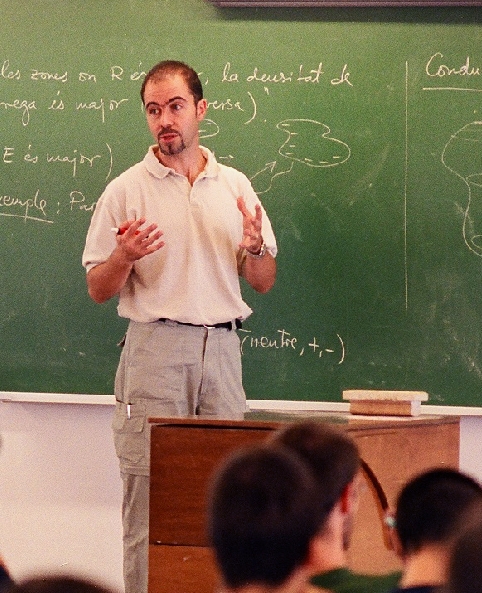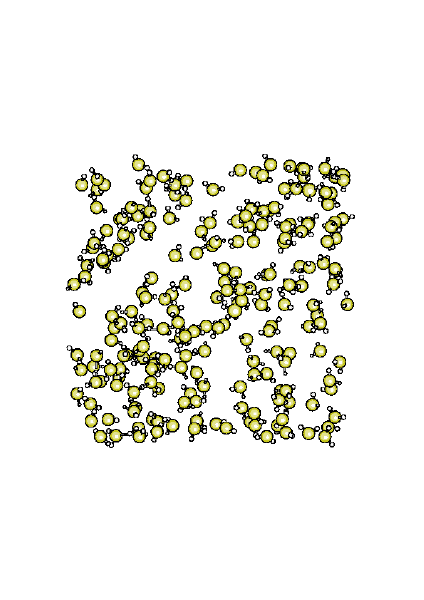Jordi Marti's Homepage
| Name | Dr. Jordi Martí i Rabassa |  |
| Address |
Departament de Física i Enginyeria Nuclear, Universitat Politècnica de Catalunya, Edifici B5 - Despatx 206, Campus Nord, Jordi Girona 1-3, 08034 Barcelona (Catalonia, Spain) |
|
| Telephone FAX |
+34 934017184 +34 934017100 |
|
| jordi.marti |
My main interest concerns the study of Condensed Matter Physics and Statistical Mechanics, focussing my work in the liquid phase. I spend most of my research activity working in theory and applications to the structure and dynamics of simple and complex liquids, with special attention paid to water, alcohols and aqueous electrolyte solutions. I have performed computer simulations with several methods: Molecular Dynamics, Monte Carlo, Empirical Valence Bond, Transition Path Sampling. In recent years, I have participated in studies of rare events and its applications to biological systems and the study of the behavior of liquid, supercritical water and ionic solutions under confinement in hydrophobic surfaces has been analyzed. We have considered mainly organic containers, in particular several forms of carbon, such as single-walled carbon nanotubes and graphene.
A. Liquid water and aqueous solutions
|
Liquid water at 298 K
|
 |
|
A tetrahedral network of water molecules is the main structural trend, due to the existence of four hydrogen-bonds per molecule (on average). The lifetime of such hydrogen-bonds is around 1 ps. Hydrogen-bonding is the main responsible of the amazing properties of liquid water. This part of my research is carried out in collaboration with Joan Àngel Padró (University of Barcelona) and Elvira Guàrdia (UPC). |
Aqueous ionic solutions at finite concentration
The effect of ion concentration is relevant to the local organization of water around ionic species and it has strong influence on dielectric properties and on dynamics, such as conductivity and diffusion coefficients or on hydrogen-bond structure and lifetimes.
B. Supercritical water
|
Structure of supercritical water at 723 K.
|
 |
|
Water beyond its critical point (T > 647.13 K, d > 0.322 g/cm³, P > 220.55 bar) shows surprising new properties, like the capacity of mixing with oil. In supercritical water there is no longer distinction between the liquid and vapor phase. We have observed the breakdown of the tetrahedral structure and its substitution by cavities and water clusters. The lifetime of hydrogen-bonds is now about 0.3-0.5 ps. This part of my research is carried out in collaboration with Elvira Guàrdia (UPC). |
C. Rare events in chemical physics and biophysics
|
Lipid chain performing a flip-flop transition in a biological membrane
|
 |
|
The study of rare events is a computational challenge due to the tiny amount of trajectories in phase space which lead to such phenomena, compared with the total amount of trajectories described by a microscopical system. A new technique named transition path sampling, which is able to analyze reactive trajectories in configurational space without preconceived information about potential energy surfaces or transition states of the system, has been recently developped by the research group of David Chandler in the University of California at Berkeley. We have employed that technique to study the transition state structure of NaCl dissociation in water and, more recently, flip-flop transitions of lipids in biomembranes. That reserach has been done in collaboration with David Chandler (University of California, Berkeley) concerning NaCl dissociation and also Félix S. Csajka (Max-Plank Institute for Colloids and Interfaces, Potsdam) about NaCl dissociation and lipid transitions. |
D. Liquid and supercritical water under confinement
|
Liquid water at 298 K adsorbed in a carbon nanotube of radius 40 nm
|
 |
|
When liquids are constrained inside solid devices, its behavior can suffer dramatic changes. In the case of water, confinement produces marked loss of structural order and modifications in its microscopic dynamics. We have simulated several liquid and supercritical water samples when constrained by rigid and soft carbon nanotube walls. One of the most relevant cases is that of quasi-one dimensional liquid water, when liquid water is simply composed by |
|
The water-solid interface
|
|
|
As another example of confinement, we have simulated liquid water imbedded in between two flat graphite layers. This is a "classical" system in simulation studies which we will use to learn further about modifications in the structure and dynamics of water under extreme confinement. In the limit, we are able to speak about 2D water.The influence of the tubes is especially relevant concerning hydrogen stretching vibrations and diffussive behavior. This research work is been produced in collaboration with M.C.Gordillo (Pablo de Olavide University at Seville), Gabor Nagy (Atomic Energy Research Institute of the Hungarian Academy of Sciences) and Elvira Guàrdia (UPC). |
|
 |
 |
E. Proton transfer in aqueous environments
|
Bulk supercritical water at 673 K.
|
|
A study of structure and dynamics of water plus an excess proton at the supercritical isotherm of 673 K was reported in 2004 and revealed new features. For instance, the diffusion behaviour of the lone charge does not follow the Grotthus mechanism, differently of what happens for water at ambient conditions. In supercritical water, the spectral features of the excess proton reveal a tendency to form Eigen-like complexes, instead of the typical behaviour of Zundel pairs at 298 K. This part of my research is carried out in collaboration with Elvira Guàrdia (UPC) and with Daniel Laria, from the National Comission of Atomic Energy in Buenos Aires (Argentina) . |
|
Excess protons in reverse micelles.
|
|
More recently, the analysis of the characteristics of the excess proton in a water droplet located inside a reverse non-ionic micelle Diethylene Glycol Monodecyl Ether has been performed. Is such system, we observe a quick diffusion of proton to the external surface of the micelle, in a similar fashion as it happens when larger ionic charges are dilutes near solid or gas-like interfaces. In this particular problem, we observed how the most common configuration is that of the excess proton forming Eigen-like complexes, which have long lifetimes of the order of nanoseconds, prior to tits eventual transfer to other water molecules. This part of my research is carried out in collaboration with Elvira Guàrdia (UPC) and with Daniel Laria and Javier Rodriguez, from the National Comission of Atomic Energy in Buenos Aires (Argentina) . |
A course in quantum field theory (in catalan), J.Martí and J.Fernández. Publicacions Promocions Universitàries. Barcelona, 1993.
Liquid water and aqueous solutions
Rare events in biochemical systems
Water under confinement (carbon nanotubes, near surfaces)
- Physics for computer science students, Faculty of Computer Science, UPC, Barcelona.
- Physical foundations of technologies applied to computer science, Faculty of Computer Science, UPC, Barcelona.
- Science, Computers and Learning, Faculty of Computer Science, UPC, Barcelona.
- Advanced Methods in Simulation, Master in Computational and Applied Physics, UPC, Barcelona.
- Physics, for Multimedia and Photography students of the "Center of Image and Multimedia Technologies" of the "Fundació Politècnica", UPC, Terrassa.
Share: